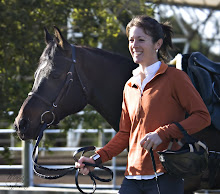I was entranced in a reverent inspection of purple wildflowers on the trail towards John Muir Pass when the commotion ahead caused our hiking party to pause. Beyond us, the trail narrowed to the width of a gang plank, with a boulder-strewn cliff falling away from its right side straight down to the creek 100 feet below. A commotion in that direction meant nothing good.
This rock slope threatened hikers that one wrong step could send them tumbling head over heels in a battering descent. It was all the more reason why the mule pack train that passed us a moment earlier impressed me so much. I pondered what an unusually reliable and well-trained group of animals they had to be. Never in my wildest thoughts would I consider riding down this trail. But I just as quickly shrugged it off as my own paranoia about the hazards of riding horses anywhere outside nice enclosed arenas. You've become too much of an arena rider, I told myself. Horses have been treading through terrain like this for centuries. There's no reason to be a sissy about trail riding. And then I returned my thoughts to the wildflowers bursting in pale colors from implausible cracks in the granite.
Just as I bent over to admire a sharp-edged Star flower, the disturbance caught my attention. Having spent my entire life with horses, it was the kind of commotion one learns to identify from the faintest few seconds of sound. The kind that means nothing good. I looked up just in time to see a brown rump bucking its way down the rocky cliff side. It belonged to the seemingly charming doe-eyed mule that, until a few seconds earlier, had led the pack train I admired moments ago. The very same group of steeds that momentarily challenged my paranoia about riding outside safe enclosed arenas.
At that time, the chocolate colored steed was ridden by a young blue-eyed cowboy in fringy chaps pulling along three smaller mules loaded heavily with boxes of gear for the back country. Obviously, though, in the short time since he passed us, he decided to surrender his role as leader and opt instead for rebellious deflector. Depositing his handsome cowboy by means of one big jump and twist and breaking free of the rope that tethered him to the three charges, he romped his way down to the creek below. Then, he lowered head to knees, gave his body a mighty shake, and slid the saddle forward over his withers onto the ground. Now free of gear, cowboy, and pack train, he curtsied back one step and began nibbling nearby shrubs.
Our party bolted up the trail to see if the rider was okay, which thankfully he was. In fact, it appeared he had chosen an emergency dismount himself, rather than try to ride his broncing mule down the granite pile. This quick thinking indicated it might not be the chocolate mule's first back country rodeo routine. Dusting off his chaps, the cowboy seemed unsurprised by the antics of his pack "leader," the leader we watched break away, untack himself, and decide to chew branches instead of lead his herd. Some leader. The three other mules stood obediently on the trail, docile and unfazed. They awaited the cowboy's next command, standing at attention like well-disciplined school children.
They made me wonder why on earth the chocolate mule (who I now thought of as Bad Mule) had acquired leader status instead of one of them. Wouldn't an obedient, quiet-natured steed be better suited to lead a pack than, say, a feisty bronc that liked to run off the trail? I wanted to query the cowboy with this, suggesting he promote the sage-looking cream colored mule in the middle to leader. This one appeared unflappable and trustworthy. He seemed to understand his job, no questions asked. But I thought better of opening my mouth to offer unsolicited advice.
I recalled not only the ever-changing whims of the steeds we ride but also the number of times passers-by probably had similar questions for me when a normally stalwart mount turned loony under me in a split second. Countless numbers of young horses at their first competitions have played out scenes similar to Bad Mule's cliff side rodeo. In the blink of an eye, they've transformed from the well-trained and capable mounts I know them to be into the world's most unruly beast. And as much as I may want to pommel them in that moment, I admit that this is just how it goes with horses. No matter their level of training or experience, our steeds still have their own whits. Generally, they want to please us. Except for that unpredictable percentage of time when they seem to want to embarrass us, take us down a notch, or simply dump us in the dirt.
In the end, I kept my mouth shut as I hiked past the cowboy figuring out how to get Bad Mule up the cliff and back on the trail. I simply nodded and walked by. I knew exactly how he felt with a combination of ire and humiliation. I pretended we saw nothing.
Tuesday, September 14, 2010
Subscribe to:
Post Comments (Atom)





1 comment:
Good story. You were tactful to pretend you didn't see :) I've had some very embarrassing moments myself, not least of which occurred at my hores's first show this past summer.
Post a Comment